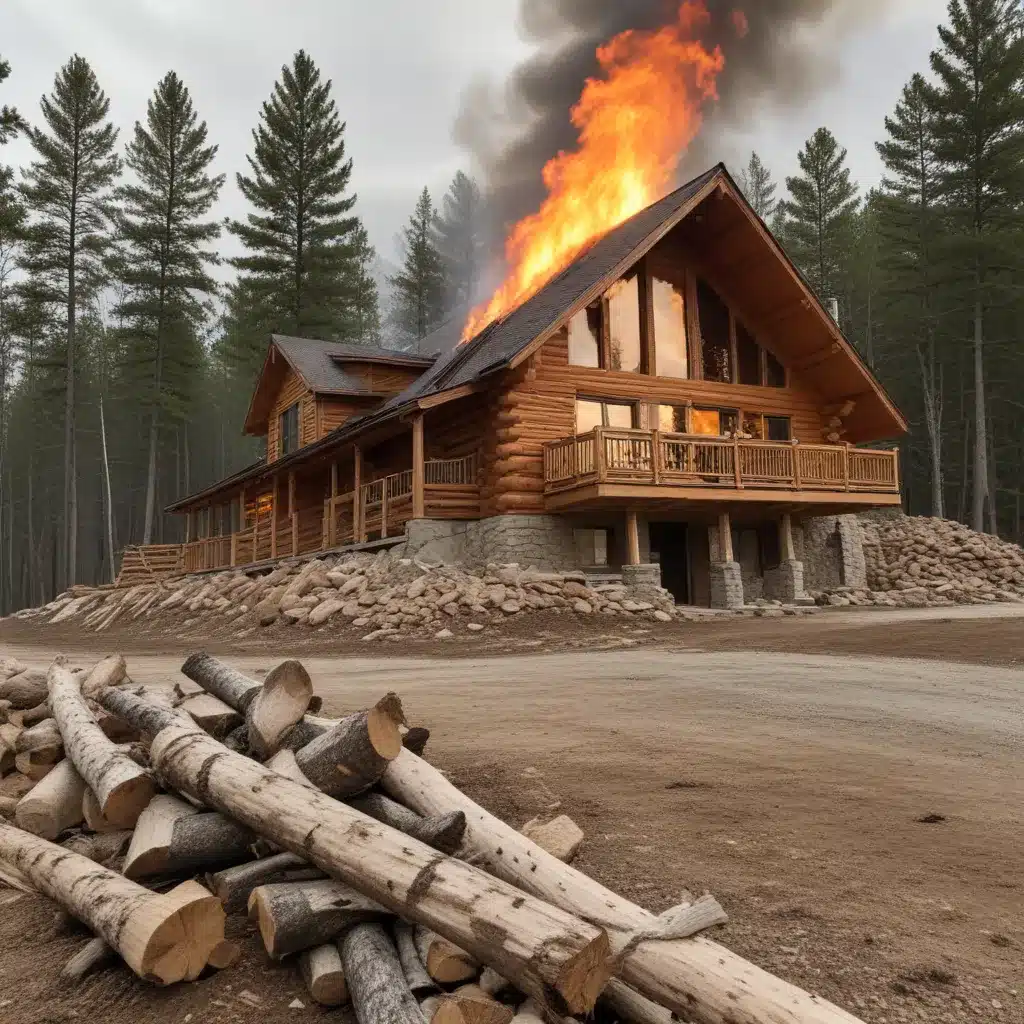
Designing Resilient Log Homes for Fire-Prone Regions
In regions prone to wildfires, constructing log homes and timber frame structures requires a thoughtful approach to minimize the risks of fire damage. As log home enthusiasts and builders, it’s crucial to understand the key principles of fire-resistant design, eco-friendly materials, and energy-efficient features that can enhance the safety and longevity of these unique dwellings.
Prioritizing Ignition-Resistant Construction
The primary goal in designing log homes for wildfire-prone areas is to create a structure that is less susceptible to ignition, both from direct flame contact and airborne embers. This starts with the selection of building materials that have inherent fire-resistant properties.
Log Choices: When it comes to log selection, opt for species that are naturally more dense and less prone to rapid combustion, such as Douglas fir, western red cedar, or lodgepole pine. These species tend to have higher thermal mass, meaning they are less likely to ignite and can better withstand the intense heat of a wildfire.
Siding and Roofing: Exterior siding and roofing materials play a critical role in a log home’s fire resistance. Consider using ignition-resistant options like metal, fiber cement, or fire-retardant treated wood siding. For roofing, Class A fire-rated asphalt shingles, metal, or tile are excellent choices that can help prevent ember intrusion and reduce the risk of roof ignition.
Eaves, Vents, and Openings: Carefully seal any gaps or openings in the home’s exterior, such as eaves, attic vents, and windows, to prevent the entry of embers. Use non-combustible materials like metal screening or ember-resistant vents to cover these vulnerable areas.
Decks and Attachments: Detach any attached structures, such as decks or fences, from the main log home. These can act as fire conduits, allowing flames to reach the home’s exterior. If attached, use fire-resistant materials like metal or concrete for these elements.
By prioritizing ignition-resistant construction techniques, homeowners can significantly improve the chances of their log home surviving a wildfire event.
Enhancing Defensible Space
In addition to hardening the home’s structure, creating a well-designed defensible space around the log home is essential. This zone, extending 100-200 feet from the home, should be carefully managed to reduce the amount of available fuel that could feed a wildfire.
Vegetation Management: Carefully prune or remove any trees, shrubs, or other vegetation that could act as fuel sources. Maintain a minimum clearance of 30 feet around the home, and thin out remaining vegetation to create discontinuous fuel beds that can slow the spread of fire.
Landscape Design: Incorporate fire-resistant landscaping elements, such as gravel, stone, or low-growing, well-hydrated plants. Avoid using mulch or other flammable materials that could ignite easily.
Accessory Structures: Carefully site any detached structures, such as sheds or outbuildings, at least 30 feet from the main log home. Use fire-resistant materials for these structures as well.
Maintenance: Ongoing maintenance is crucial to maintaining an effective defensible space. Regularly clear gutters, remove debris from roofs, and tend to the landscaping to ensure it remains fire-resistant.
By creating a well-designed defensible space, homeowners can significantly reduce the risk of their log home being directly threatened by wildfire flames or embers.
Improving Energy Efficiency
In addition to fire safety, log home owners should also consider the energy efficiency of their dwellings. Enhancing the thermal performance of a log home can not only reduce energy costs but also contribute to its overall sustainability.
Insulation: While log walls provide some inherent insulation, adding supplemental insulation, particularly in the roof and walls, can further improve the home’s energy efficiency. Consider using high-performance insulation materials like closed-cell spray foam or mineral wool batts.
Windows and Doors: Investing in energy-efficient windows and doors with low-E coatings and tight seals can help minimize heat transfer and air infiltration, leading to lower energy consumption.
Heating and Cooling Systems: Opt for high-efficiency HVAC systems, such as heat pumps or geothermal systems, to reduce the energy required for heating and cooling the log home.
Renewable Energy: Integrating renewable energy sources, like solar photovoltaic panels or a small wind turbine, can offset the home’s energy use and reduce its carbon footprint.
By prioritizing energy-efficient features, log home owners can create a more sustainable and cost-effective living environment, further enhancing the long-term viability of their investment.
Estimated Costs for Log Home Construction
The cost of constructing a log home can vary significantly depending on factors such as location, size, and the level of customization. However, as a general guideline, the average cost for a log home in the United States as of September 2024 can be estimated as follows:
| Cost Element | Average Cost (USD) |
|---|---|
| Log Materials | $80 – $150 per square foot |
| Foundation | $15 – $30 per square foot |
| Exterior Siding and Roofing | $20 – $50 per square foot |
| Windows and Doors | $15 – $30 per square foot |
| Insulation and Weatherproofing | $10 – $20 per square foot |
| Heating and Cooling Systems | $10 – $25 per square foot |
| Renewable Energy (optional) | $20 – $50 per square foot |
| Labor and Construction | $100 – $200 per square foot |
| Total Estimated Cost | $270 – $455 per square foot |
These figures are rough estimates and can vary based on the specific region, local market conditions, and the level of customization desired. It’s important for prospective log home owners to work closely with experienced builders and contractors to obtain accurate cost estimates for their project.
Conclusion
Constructing a log home in a wildfire-prone region requires a comprehensive approach that balances fire safety, energy efficiency, and sustainable design. By prioritizing ignition-resistant materials, creating effective defensible spaces, and incorporating energy-efficient features, log home owners can create resilient, eco-friendly, and cost-effective dwellings that can withstand the challenges posed by wildfires.
For more information on log home construction and design, please visit Jorgensen Log Homes, a leading provider of custom log home solutions in the United States.


